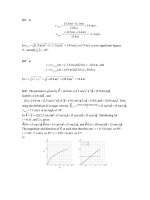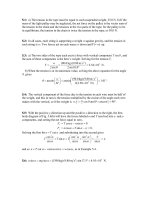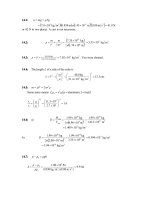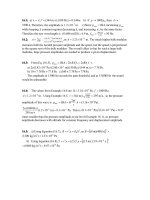Tài liệu Physics exercises_solution: Chapter 04 pdf
Bạn đang xem bản rút gọn của tài liệu. Xem và tải ngay bản đầy đủ của tài liệu tại đây (225.49 KB, 21 trang )
4.1: a) For the magnitude of the sum to be the sum of the magnitudes, the forces must
be parallel, and the angle between them is zero. b) The forces form the sides of a right
isosceles triangle, and the angle between them is
90
. Alternatively, the law of cosines
may be used as
,cos22
2
2
22
FFFF
from which
cos 0
, and the forces are perpendicular. c) For the sum to have 0
magnitude, the forces must be antiparallel, and the angle between them is
180
.
4.2: In the new coordinates, the 120-N force acts at an angle of
53
from the
x
-axis,
or
233
from the
x
-axis, and the 50-N force acts at an angle of
323
from the
x
-
axis.
a) The components of the net force are
N32323cos)N50(233cos)N120(
x
R
.N124323sin)N50(233sin)N120()N250(
y
R
b)
,N128
22
yx
RRR
104arctan
32
124
.
The results have the same magnitude,
and the angle has been changed by the amount
)37(
that the coordinates have been
rotated.
4.3: The horizontal component of the force is
N1.745cos)N10(
to the right and the
vertical component is
N1.745sin)N10(
down.
4.4: a)
,cos
FF
x
where
is the angle that the rope makes with the ramp (
30θ
in
this problem), so
.N3.69
30cos
N0.60
cos
x
F
F F
b)
N.6.34tansin θFθFF
xy
4.5: Of the many ways to do this problem, two are presented here.
Geometric: From the law of cosines, the magnitude of the resultant is
.N49460cos)N300)(N270(2)N300()N270(
22
R
The angle between the resultant and dog A’s rope (the angle opposite the side
corresponding to the 250-N force in a vector diagram) is then
.7.31
N494
)N300(120sin
arcsin
Components: Taking the
x
-direction to be along dog A’s rope, the components of the
resultant are
N42060cos)N300()N270(
x
R
,N8.25960sin)N300(
y
R
so
.7.31arctan,N494)N8.259()N420(
420
8.259
22
θR
4.6: a)
N10.8)9.126(cos)N00.6(120cos)N00.9(
21
xx
FF
N.00.3)9.126(sin)N00.6(120sin)N00.9(
21
yy
FF
b)
N.8.64N)(3.00N)10.8(
2222
yx
RRR
4.7:
2
s/m2.2kg)(60N)132(/ /mFa
(to two places).
4.8:
.N189)m/skg)(1.40135(
2
maF
4.9:
kg.16.00)m/sN)/(3.000.48(/
2
aFm
4.10: a) The acceleration is
2
s)(5.00
)m0.11(2
2
s/m88.0
22
t
x
a
. The mass is then
kg.9.90
2
m/s0.88
N0.80
a
F
m
b) The speed at the end of the first 5.00 seconds is
m/s4.4at
, and the block on the
frictionless surface will continue to move at this speed, so it will move another
m0.22vt
in the next 5.00 s.
4.11: a) During the first 2.00 s, the acceleration of the puck is
2
m/s563.1/ mF
(keeping an extra figure). At
s00.2t
, the speed is
m/s13.3at
and the position is
m13.32/2/
2
vtat
. b) The acceleration during this period is also
2
m/s563.1
, and the
speed at 7.00 s is
m/s6.26s)00.2)(m/s(1.563m/s13.3
2
. The position at
s00.5t
is
m125s)2.00sm/s)(5.00(3.13m13.3 x
, and at
s00.7t
is
m,21.89s))(2.00m/s3(1/2)(1.56s)m/s)(2.00(3.13m12.5
22
or 21.9 m to three places.
4.12: a)
.m/s31.4kg5.32/N140/
2
mFa
x
b) With
m215,0
2
2
1
0
atxv
x
.
c) With
m/s0.43/2,0
0
txtavv
xxx
.
4.13: a)
0 F
b), c), d)
4.14: a) With
0
0
x
v
,
.m/s1050.2
)m1080.1(2
)m/s1000.3(
2
214
2
262
x
v
a
x
x
b)
s1020.1
8
s/m1050.2
s/m1000.3
214
6
x
x
a
v
t
. Note that this time is also the distance divided by
the average speed.
c)
N.1028.2)m/s1050.2)(kg1011.9(
1621431
maF
4.15:
.N1094.2)m/s80.9)(m/s12)(N2400()/(
322
gawmaF
4.16:
.m/s0.22)m/s80.9(
2.71
160
/
22
g
w
F
gw
F
m
F
a
4.17: a)
kg49.4)m/s80.9/()N0.44(/
2
gwm
b) The mass is the same, 4.49 kg, and
the weight is
.N13.8)m/s81.1)(kg49.4(
2
4.18: a) From Eq. (4.9),
kg.327.0)s/m80.9/()N20.3(/
2
gwm
b)
N.137)s/m80.9)(kg0.14(
2
mgw
4.19:
N.825)s/m15)(kg55(
2
maF
The net forward force on the sprinter is
exerted by the blocks. (The sprinter exerts a backward force on the blocks.)
4.20: a) the earth (gravity) b) 4 N, the book c) no d) 4 N, the earth, the book, up e) 4 N,
the hand, the book, down f) second g) third h) no i) no j) yes k) yes l) one (gravity) m) no
4.21: a) When air resistance is not neglected, the net force on the bottle is the weight of
the bottle plus the force of air resistance. b) The bottle exerts an upward force on the
earth, and a downward force on the air.
4.22: The reaction to the upward normal force on the passenger is the downward normal
force, also of magnitude 620 N, that the passenger exerts on the floor. The reaction to the
passenger’s weight is the gravitational force that the passenger exerts on the earth,
upward and also of magnitude 650 N.
.m/s452.0
2
m/s/9.80N650
N650N620
2
m
F
The passenger’s
acceleration is
2
s/m452.0
, downward.
4.23:
.s/m104.7
)kg100.6(
)s/m80.9)(kg45(
223
24
2
EE
E
m
mg
m
F
a
4.24: (a) Each crate can be considered a single particle:
AB
F
(the force on
A
m
due to
B
m
) and
BA
F
(the force on
B
m
due to
A
m
) form an
action-reaction pair.
(b) Since there is no horizontal force opposing F, any value of F, no matter how
small, will cause the crates to accelerate to the right. The weight of the two crates acts at
a right angle to the horizontal, and is in any case balanced by the upward force of the
surface on them.
4.25: The ball must accelerate eastward with the same acceleration as the train. There
must be an eastward component of the tension to provide this acceleration, so the ball
hangs at an angle relative to the vertical. The net force on the ball is not zero.
4.26: The box can be considered a single particle.
For the truck:
The box’s friction force on the truck bed and the truck bed’s friction force on the box
form an action-reaction pair. There would also be some small air-resistance force action
to the left, presumably negligible at this speed.
4.27: a)
b) For the chair,
0
y
a
so
yy
maF
gives
037sin Fmgn
N142n
4.28: a)
b)
sinmgT
N2790.26sin)s/m80.9)(kg0.65(
2
4.29: tricycle and Frank
T is the force exerted by the rope and
g
f
is the force the ground exerts on the tricycle.
spot and the wagon
T
is the force exerted by the rope. T and
T
form a third-law action-reaction pair,
.TT
4.30: a) The stopping time is
.s1043.7
4
s/m350
)m130.0(2
)2/(
0
v
x
v
x
ave
b)
.N848)kg1080.1(
s)10(7.43
)s/m350(
3
4-
maF
(Using
xva 2/
2
0
gives the same
result.)
4.31: Take the
x
-direction to be along
1
F
and the
y
-direction to be along
R
. Then
N1300
2
x
F
and
N1300
2
y
F
, so
N1838
2
F
, at an angle of
135
from
1
F
.
4.32: Get g on X:
2
2
1
gty
2
)s2.2(
2
1
m0.10
g
2
s/m13.4g
N41.0)s/m03.4)(kg100.0(
2
XX
mgw









